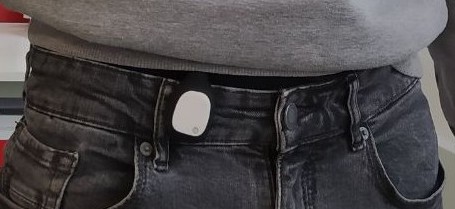Fall Detection System
Overview
In ARCO Research Group, in the context of the European project H2020 Shapes, we are working in a set of solutions to encourage the active ageing and improve the health condition at an advanced age. One of these solutions is a fall detection system that will allow us to automatically detect when a person has fell, in order to provide a prompt response. The system here presented could be a very powerful and useful tool, taking into account that falls are the leading cause of accidental death.
Warning!
Fundamentals
In order to build this system an Intertial Measure Unit (IMU) will be used, specifically a MetamotionR sensor, which was already presented
in our preovious recipe,
where we explained how to use our library to extract different data from it. This IMU can give us information about
the movement with two 3-AXIS sensor, an accelerometer and a gyroscope, but the raw data by itself does not give meaningful information and
for this reason we have to preprocess it to get the intended information. This sensor also counts with a magnetometer, that can be
useful to calculate the orientation of the sensor, considering the earth’s magnetic field. In our case we have decided to place the
sensor in the user’s waist, because it is the center of gravity of a person, and it is sensitive to abrupt changes in the measurements
of the IMU when a fall occurs. You can see underneath the sensor and where it has been placed.

We have developed an algorithm which is a mixture of the two types of algorithms used for fall detection, Threshold algorithm and
Machine Learning Algorithm. The thresholds algorithm are mainly used in low performance devices. Our threshold algorithm is
a Finite State Machine that check if the inertial measures (mainly acceleration) exceed a threshold under certain circumstances,
if this requisite is achieved, then a series of features is extracted from the raw data in a window os 1 second. With the previous
features, a model is trained to detect whether this can be considered a fall (in our case we are using SVM), so introducing the features extracted
to our model we can know if they correspond to a fall. Why do we need a model? Well, this is a good question, and all is about the
Activities of Daily Living (ADL).
Along the day, we carry out many different activites that can be tracked by our imus, if we only use a threshold algorithm it is possible that a lot of activites that do not involve a fall can overpass the selected threshold, leading to a false positive. To avoid this scenarios, a model previously trained with labeled data can help us to reduce this false-positive case. At the same time, the threshold algoritm can act as a filter, in order to avoid a frequent extraction of features and evaluations by the model.
In the data collection, the most important ADL identified that can cause a false positive are the following:
- Hitting the sensor
- Jumping
- Running
- Sitting in a chair or a sofa
To train the model, we have collected data from the previous ADLs and the following falls:
- Backward fall
- Left-side fall
- Right-side fall
- Front fall
All the falls have been made using a mattress, you may think that using a mattress could alter the data, but not using it would also alter it, because pretend falls would be performed with fear. We concluded that the best approach was to use a mattress because the data is less altered due to more natural falls.
Training model
At this point, we are using only one subject for both training and testing. The environment where the data has being collected was the ARCO Research Group’s lab, located in the Technology and System Information Institute (ITSI). Following you can see the mattress used for the falls.

The activities carried out in the collection are these:
- 10x Hitting the sensor
- 10x Jumping
- 10x Running
- 10x Sitting on a chair or a sofa
- 5x Backward fall
- 5x Left-side fall
- 5x Right-side fall
- 5x Front fall
With this data, we have trained the SVM model that is going to be used for testing purpose.
Testing algorithm
For testing purpose, training activities have been repeated in the following way:
- 3x Hitting the sensor
- 3x Jumping
- 3x Running
- 3x Sitting on a chair or a sofa
- 3x Backward fall
- 3x Left-side fall
- 3x Right-side fall
- 3x Front fall
In the next table you can see the results:
| Exercise | True Positive | True Negative | False Positive | False Negative |
|---|---|---|---|---|
| Hitting the sensor | 3 | |||
| Jumping | 3 | |||
| Running | 3 | |||
| Sitting on a chair | 3 | |||
| Front fall | 3 | |||
| Left-side fall | 3 | |||
| Right-side fall | 3 | |||
| Backward fall | 2 | 1 |
As you can see, almost all the results are the expected, with the exception of one backward fall, which produce a wrong result. It has to be noted that the tests were made with the same subject used for training the model. To summarize, our system with the tests made has a reliability of 95,83%. In future works, we are going to collect data from more subjects, create a more complete battery of tests, and finally deploy this solutions in a real environment, monitoring the residents from the nursing home El Salvador in order to test our system.
